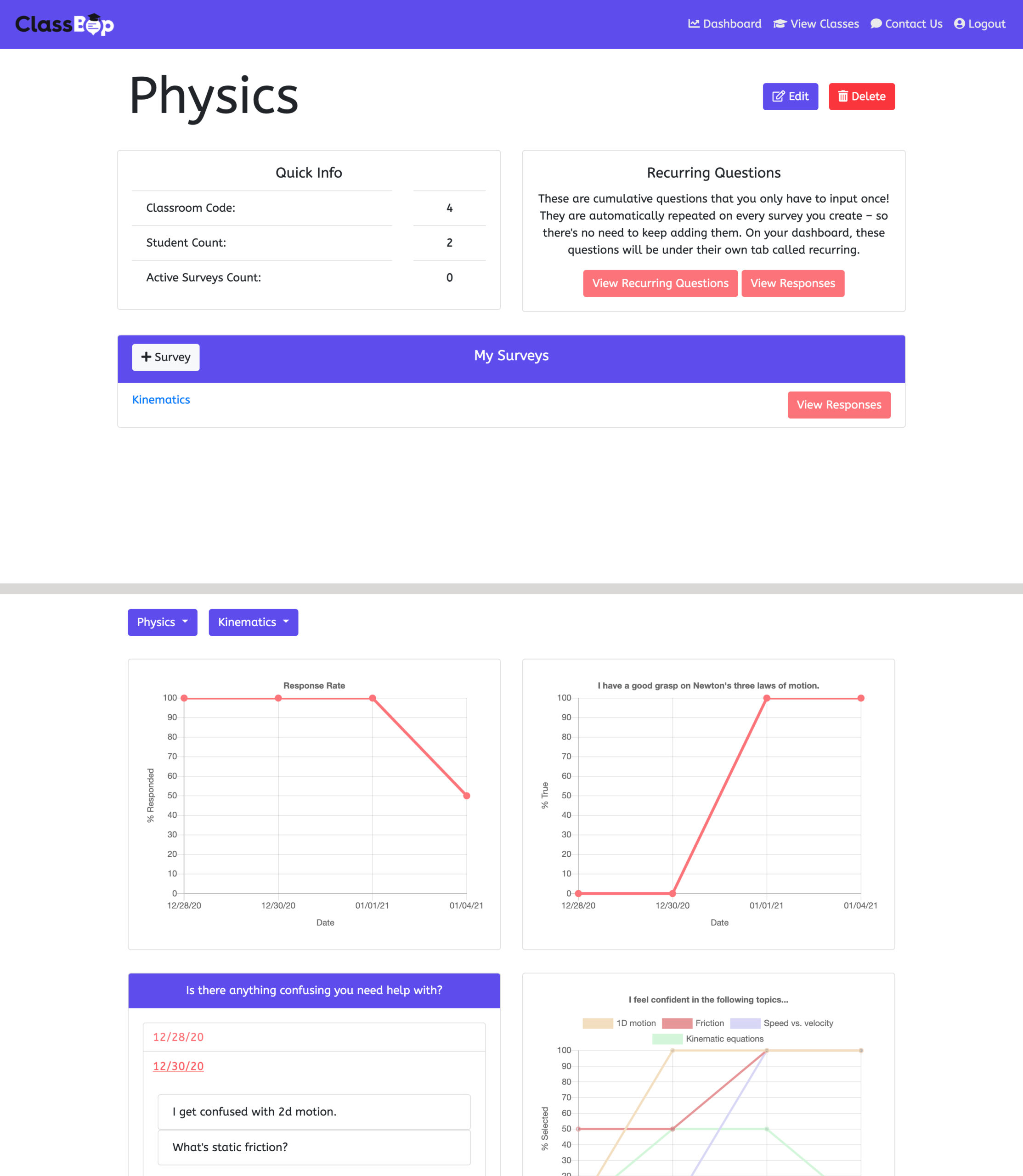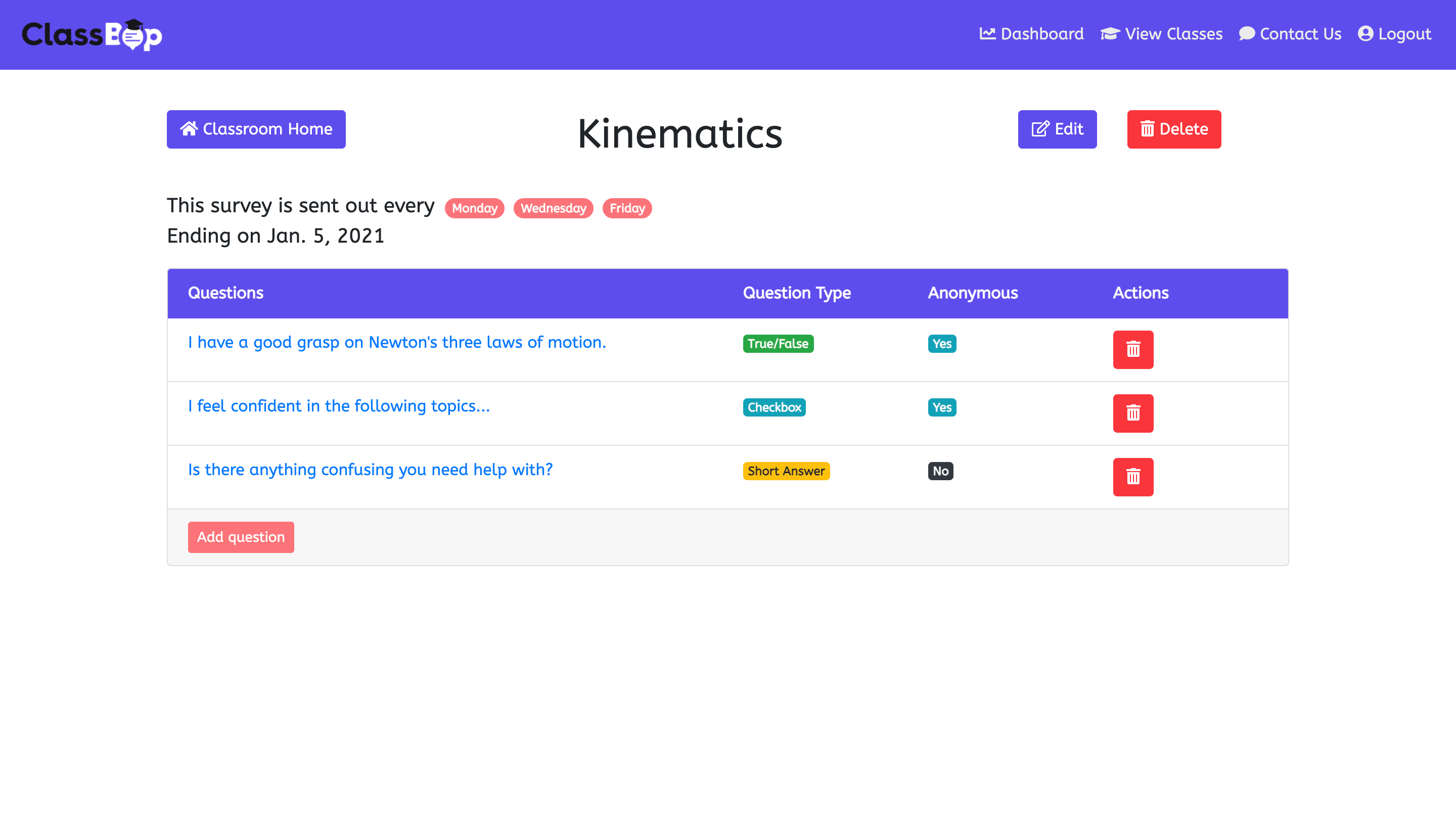ClassBop: Student to Teacher Feedback Made Simple
Check out Classbop:
Finals Presentation | Website
Underfunded public education and teachers who struggle to find enough time in the day to meet their students’ needs. These are well-known challenges in education, so one can only imagine what trying to teach in a virtual environment entails: accidentally unmuted mics, weak wifi signals, and students with their cameras off who give no apparent sign of their presence other than the letter representing their name as a participant.
Story by Sydney Moore

Top: A screenshot of ClassBop’s prototype dashboard; Bottom: Several examples of the metrics ClassBop pulls from survey feedback.
No matter how it’s put, it is simply harder to know how students are really doing from behind a screen. That’s where ClassBop-created by Roni, Raeed, Edward, and Cindy-comes into play. ClassBop is a platform designed to ease a teacher’s workload by instituting technology that makes student to teacher feedback simple.
Most high school teachers regularly collect feedback at the end of the semester, but while this information is helpful, it’s not dynamic enough to meet the needs of their current students. By the time teachers process the feedback, it’s time to move on to a new class. In addition, teachers in multiple school districts find it a hassle to efficiently collect and organize feedback in a way that is understandable.
ClassBop focuses on helping teachers collect, manage, and learn from consistent feedback. The platform has students use an automated process. Teachers only have to set up the surveys and everything else is taken care of by the platform. Over time, Classbop even gives teachers the ability to see statistics and comments.
ClassBop prioritizes eliminating implicit bias, a common concern with collecting feedback. The platform is designed so that information from the surveys can not negatively impact a student’s future career or performance. And on the teacher’s side prompts have to be heavily screened and selected with care.
LESSONS LEARNED FROM THE DESIGN PROCESS

An example of the different questions types teachers can use.
Team members Ronit and Raeed formed the idea for ClassBop while participating in Optimize, and a few months later Cindy and Edward joined. The group was originally looking at bringing this platform to all ages. Since then, the team has redefined their target demographic to high school teachers. This decision came after they realized that high school teachers tend to interact with the same classes every day, which facilitates an ability to adjust their teaching and consistently get feedback from the same students. That being said, ClassBop is still looking to test with college-age students and other ages.
In hindsight, the team believes their collective experience in technology was the single biggest factor for the successful development of their project, but they also think everyone’s hunger to learn about entrepreneurship helped with what they lacked in experience.
For instance, the team’s Computer Science majors made the development of the platform much easier. To build the prototype for the platform, the team was able to teach themselves web development. However, the team also said joining Innovation in Action (IiA) gave them the outside perspective they needed since they are all so technically oriented. Participating in Learning Lever, where they became a finalist, was also a great learning opportunity.
From these programs, the team learned how to interview customers and stakeholders in a way that reveals what problems should take priority. During the IiA design process, ClassBop learned how to get a diverse set of teachers and administrators involved. They talked to stakeholders across the education system to get a full picture of what tools were needed in the classroom. Another big takeaway from IiA was how important intuitive design is. For user friendliness, the goals should be to minimize the amount of clicks required to do tasks.
A huge challenge ClassBop faced resulted from going through the design process backwards: creating the prototype and then focusing on customer discovery. The team said “oftentimes customers may provide a false sense of security by praising your idea just to be nice. It’s important to focus on the customer and their problems to validate the usefulness of your solution.”
A piece of advice from the team is that the education landscape is extremely hard to break into because of the rather decentralized nature of school districts. Each district has different school policies and software needs. You need to do extensive customer discovery interviews to understand your customers well and have a solid plan for how your project will expand.
Going into the future, ClassBop is helping teachers integrate the platform technology into their classrooms. They are planning on launching an updated version in 2022, which will be marketed to school districts. Check out their current platform at www.classbop.com!



